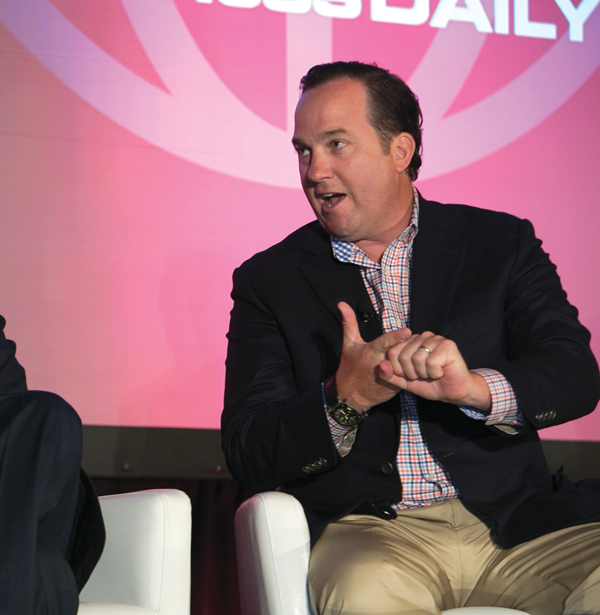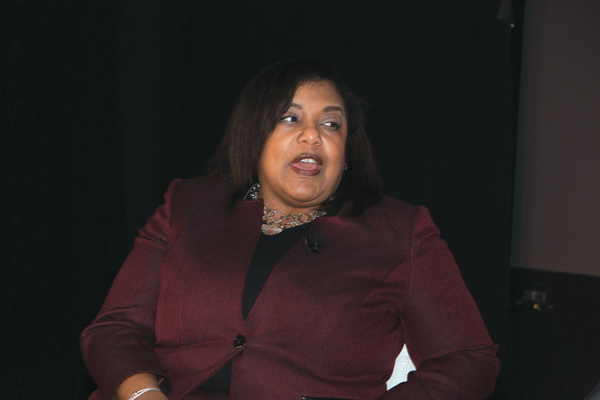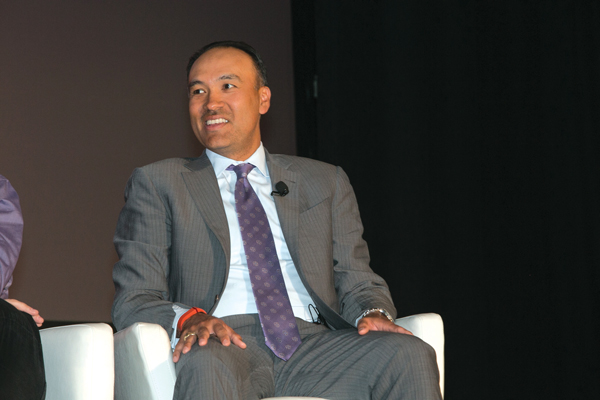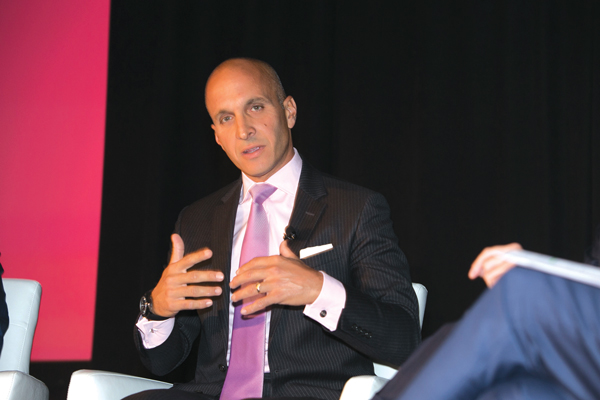With angst over how to bond with young fans reaching a fever pitch, it’s fair to wonder whether sports simply won’t be as important to future generations.
But most industry leaders gathered at the CAA World Congress of Sports last week are confident. In their eyes, there’s nothing wrong that can’t be fixed by the right marketer, right deal or right technology. It’s just going to take bold thinking.
“When you start at the top and ask, ‘Is there more interest in sports than ever?’ The answer is absolutely yes,” said Michael Rubin, founder and executive chairman of Fanatics, and co-owner of the Philadelphia 76ers and New Jersey Devils. “The question is, ‘How do we best service that fan?’ I think you get a bunch of smart people in the world thinking about it, and we’re going to keep doing a better job of it. I’m actually not concerned. I think it’s an opportunity.”
Over the two days, executives stressed the need to reinvent sports programming to resonate with a mobile generation that requires on-demand, short-form media.
First Look podcast at World Congress of Sports:
Perspectives ranged widely on how revolutionary the changes must be, with some media executives sticking with their faith that live sports will always carry a unique value proposition, regardless of how it’s packaged, and others describing a wide gap between what the younger generation wants and what sports provide.
“My son is a baseball fan — he plays baseball,” said Michael Levine, co-head of CAA Sports. “He comes to Yankee Stadium and has a great time. I don’t think he and any of his buddies have ever sat down and watched a Yankee game from beginning to end on TV, and that’s scary to me.”
In the 2010s, almost every league and sports property has looked at changing its competitive rules to better compete in a modern media landscape, with college basketball, NASCAR and Major League Baseball taking the boldest steps. While that experimentation continues, the bigger task, many said, is how to present live, grand-scale sporting events to an attention-span-challenged generation.
ON THE RECORD
STRAIGHT TALK FROM
WORLD CONGRESS
PHOTOS BY TONY FLOREZ PHOTOGRAPHY
“You’re reaching some level of critical mass, but yet don’t know a lot of things that will, A, help advance the business and, B, monetize the business going forward.”
David Preschlack | President,
NBC Sports Regional Networks
on consumer behavior around streaming
“If you put the right content in front of the right consumer, they’ll give you not only the 7 seconds, but up to 2.5 minutes, and sometimes even more.”
Telisa Yancy | Chief marketing officer, American Family Insurance
on her brand’s use of longer-form digital videos
“If you have competitive games, big brands and good storylines, the ratings will be just fine.”
David Levy | President, Turner
on worry about declining TV ratings
“As a sports league, you have to create an environment … for a player to understand they have a platform, they have a voice, and they can make a difference. That’s what we try to communicate to our players.”
Mark Tatum | Deputy commissioner
and chief operating officer, NBA
on social activism among athletes
“Whoever the president is, it’s good to have the president as a fan of the game and a proponent. Whether it’s President Trump, Obama, Clinton or either of the Bushes.”
Pete Bevacqua | CEO, PGA of America
on Donald Trump’s relationship to golf
“You see fans taking their pics and doing selfies in front of the stuff we’ve done on the outside of the stadium. It’s not a normal naming-rights deal.”
Chris Koch | CEO, New Era Cap Co.
on the company’s naming-rights deal for the Buffalo Bills’ stadium
“Digestible, short-form content is here to stay,” said Andrew Judelson, WME-IMG executive vice president of sales and marketing and former Sports Illustrated Group chief marketing officer. “Sports sets itself up well within that format, whether it’s highlights, recaps or whatever.”
Judelson continued: “My kids watch YouTube highlights far more than regular, long-form programming, so you can see what’s coming. You see consumption patterns shifting, but at the same time the live element of sports will continue to set it apart from a generation that wants to go watch whatever they want, whenever they want to.”
Live sports will never be watchable literally “whenever they want,” but streaming coverage of in-market games is a step in that direction by freeing a fan from the need to be in front of a TV, agreed David Preschlack, president of NBC Sports Regional Networks.
He’s excited by the prospect of learning more about the identity of the consumers who stream, and gaining new insights into consumer behavior and preferences.
“If anything I think that speaks to the opportunity ahead,” Preschlack said. “You’re reaching some level of critical mass [in streaming], but yet don’t know a lot of things that will, A, help advance the business and, B, monetize the business going forward.”
But the media deals to enable such creativity have been slow to develop. In MLB, for instance, the Dodgers, Nationals and Orioles still lack local streaming deals, even though that is now a widespread consumer expectation. And the deals that have pushed the envelope on digital distribution are the work of properties led by people with special personal interest in digital media, such as Ted Leonsis and Steve Ballmer.
When the major sports rights packages are up in the early 2020s, Turner Sports President David Levy predicted, TV providers will create joint bids with online streaming providers like Amazon, creating a combination of reach and advanced audience metrics that can fully monetize a multi-platform approach that can better connect with new audiences.
“If there is opportunity to bid as a combined entity, I think there is a lot of power,” Levy said.
Fox Sports Regional Networks President Jeff Krolik thinks full-fledged “TV everywhere” will bring subscribers back. “Now you can take your television with you, and we think that’s going to bend the curve in subscriber decline,” he said. “You get a lot more value for your $100 subscription than you [did] before.” Skinny bundles and the growth of cable alternatives such as PlayStation Vue, Sling and YouTube TV will make for cheaper alternatives, too, he said.
Esports was a popular topic at the conference in Dana Point, Calif., but not necessarily because everyone is convinced it’s a huge moneymaker. Opinions were mixed on just how big the esports opportunity is. Sixers co-owner David Blitzer even admitted on stage that he doesn’t know exactly what he bought with Team Dignitas.
But they do know that esports has done something that traditional sports are desperate to: Build a deeply engaged, resilient fan base among men under the age of 35.
“Advertisers need to find audience and engagement, and there’s an engagement level that’s unique and unlike anything we’ve seen in my career,” said Levine, whose agency helped Riot Games strike a $300 million streaming rights and development deal with BAM Tech. For instance, the average Twitch viewer is on the site for 106 minutes per day and reports extraordinary devotion to his or her favorite esports teams and athletes.
Angela Ruggiero, a member of the International Olympic Committee and co-founder of the Innovation Sports Lab, said traditional sports can take lessons from how esports fans became so invested to begin with.
“I think it would behoove the traditional sports industry not to dismiss it, but to actually embrace it and understand what they’re doing to reach the younger consumers and the target audience we all say we want,” Ruggiero said.
In esports, athletes can solicit donations to support their play live online, or tell their fans to watch an advertisement, and fans can speak back to the stars and talk amongst each other. Meanwhile, traditional sports are still figuring out how to make their events more social and interactive, and to build their personalities better.
“From an engagement perspective, athletes in traditional sports are increasingly talking directly to the fan,” Ruggiero said. “They’re on Twitter. They’re creating interesting content. Well, the gamer side of it, that’s literally the model it’s built on.”
The challenges of adapting a business designed around two or three hours of continuous content for an audience that’s more accustomed to watching for a few minutes at a time seem daunting. But if the audience moves in that direction, the incentives to change will accelerate, said Michael Neuman, managing partner at Horizon Media’s Scout Sports & Entertainment.
“It’s not the length of the content, it’s the size of the audience, and eventually a larger number will move over,” Neuman said. “We may get to a time when it will cost you more as an advertiser to be associated with that content, because the quality of that audience may be higher. However, remember how quickly Vine came and went, so …”
Ken Shropshire, a professor and faculty director of the Wharton Sports Business Initiative, said properties must think about packaging sports for new media consumption in every part of their business. He pointed to the Drone Racing League as an example.
“The good news for this industry is that this generation consumes just as much (video and sports), they just do it differently,” Shropshire said. “So the sooner people come to terms with monetizing short form and quit trying to sell the three-hour full game, the better prepared they will be for the new reality.”
Brands are eager for a solution, said Joao Chueiri, vice president of consumer connections, media, digital, sports and entertainment for Anheuser-Busch.
“These are the most fundamental questions for the industry today: how to shape programming of games and leagues in a way that truly connects with the new audience,” Chueiri said. “To unlock those questions will help us both. There’s a critical need for a new model on both sides. It needs to evolve.”









